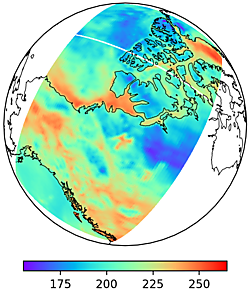Prof. Thomas J. Duck’s Polar Remote Sensing research group is located in the Department of Physics and Atmospheric Science at Dalhousie University, in beautiful Halifax, Nova Scotia (Canada).

We use microwave satellite remote sensing to measure water vapour columns, surface emitting-layer temperatures, and surface emissivities in the polar regions. Retrievals are performed using optimal estimation and some of the latest advances in artificial neural network (ANN) technology. The data are useful for climate research and numerical weather prediction.
Students who are interested to join the group should contact Prof. Duck directly (info at bottom). We are always on the lookout for applicants with strong analytical, quantitative, and programming abilities. In the course of our research, students can expect to learn remote-sensing techniques, radiative transfer and how it is modelled, and modern programming practices and data analysis methods. We use the Python programming language and pytorch in our work. Graduates of the group have continued on to successful careers in industry, government, and academia.
Earlier studies by the group involved the development and operation of laser radar (lidar) systems for the Arctic and Mars. Prof. Duck was co-founder of the Canadian Network for the Detection of Atmospheric Change (CANDAC) which operates the Polar Environment Atmospheric Research Laboratory (PEARL) in the High Arctic at Eureka. He was also a Co-Investigator on the 2008 Phoenix Mars Scout mission. See our publications for more information.
We are grateful for funding from NSERC to carry out our research.
Contact Information
Department of Physics and Atmospheric Science, Dalhousie University,
Sir James Dunn Building, 6310 Coburg Road, PO Box 15000
Halifax, Nova Scotia, Canada, B3H 4R2.